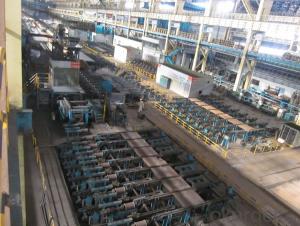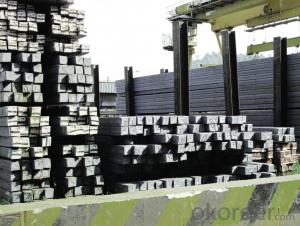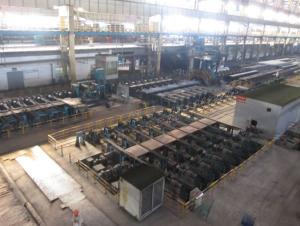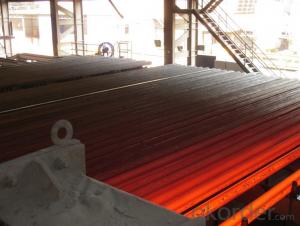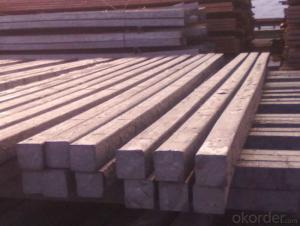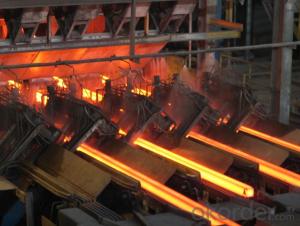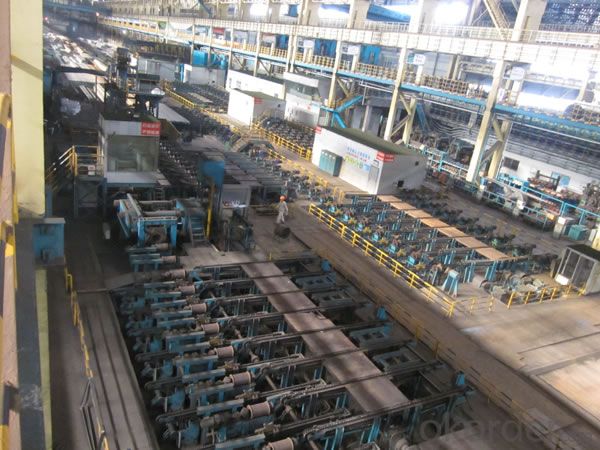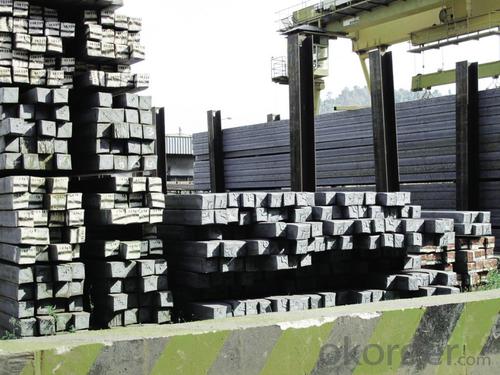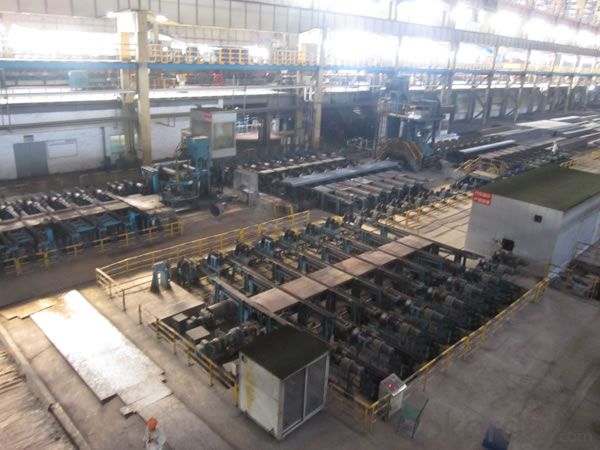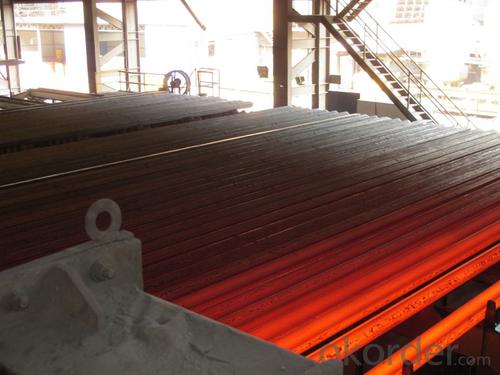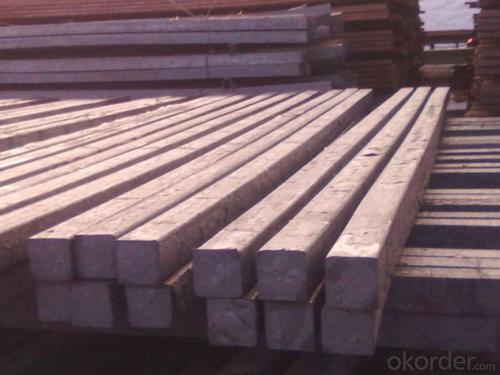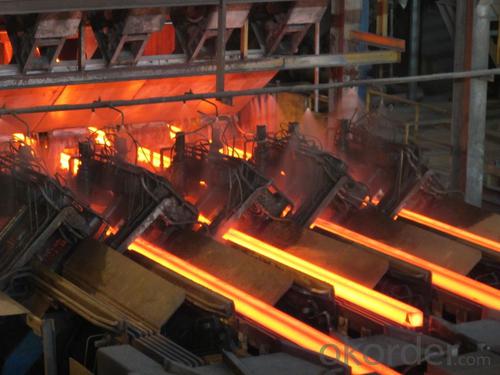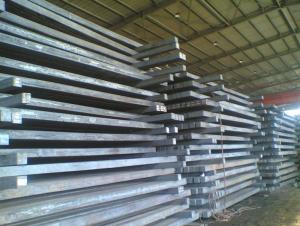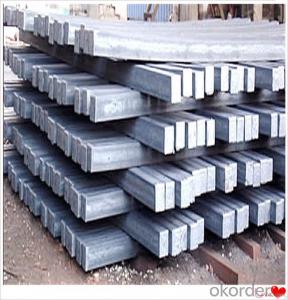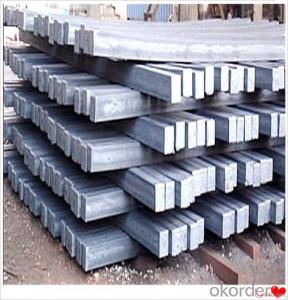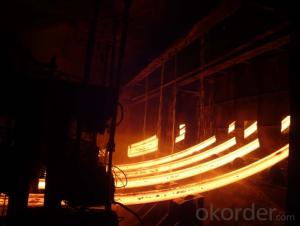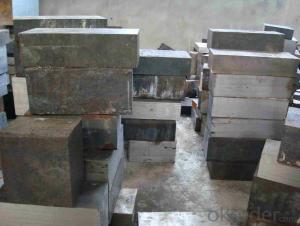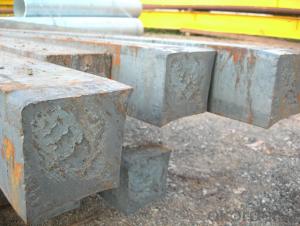Q235/3SP 70MM Blast Furnace Hot Rolled Steel Billet
- Loading Port:
- Tianjin
- Payment Terms:
- TT OR LC
- Min Order Qty:
- 2000 m.t.
- Supply Capability:
- 30000 m.t./month
OKorder Service Pledge
OKorder Financial Service
You Might Also Like
Description of Q235/3SP 70MM Blast Furnace Hot Rolled Steel Billet
Our hot dip galvanised steels consist of a steel substrate with a metallic zinc coating applied by means of a continuous hot dip galvanising process. Metallic zinc coatings are available in steel grades ranging from steel for bending and deep drawing applications, to structural steels and high yield strength steels.
A glossy surface finish obtained under specific skin-pass conditions (either non-skin-passed or skin- passed with smooth cylinders to obtain low roughness) can be provided if required at time of enquiry.
Advantage of Q235/3SP 70MM Blast Furnace Hot Rolled Steel Billet
Uncoated CR steel sheet With the features of in line with the international highest standards in demension and shape, excellent surface finish and properties, the products are mainly used in home appliance and automobile industries.
Galvanized steel sheet(include HDG and EG)
With the features of good corrosion resistance, the products are mainly used in automobile, home appliance, electronics, building and machinery manufacture industries, etc.
Precoated steel sheet With the features of enviromental protection and good processablility, long lasting surface durability, rich in colors, the products are maily used in building, home appliance and furniture industries, etc.
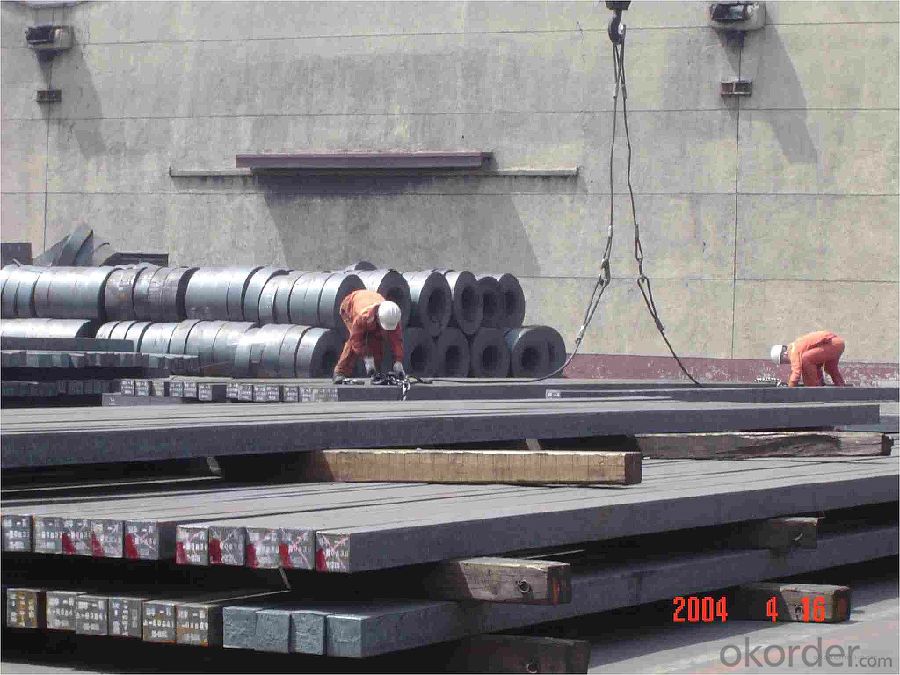
Applications of Q235/3SP 70MM Blast Furnace Hot Rolled Steel Billet
Our hot dip galvanised steels can be used in a very wide range of applications for industrial markets, both indoors and outdoors. Some of the most common applications are:
Building: wide sections for roofing and cladding, doors, door frames, metallic ceilings, partitions, structural members etc
Domestic appliances: all appliances for this sector (both white and brown goods) are manufactured with hot dip galvanised steels
Miscellaneous: electrical cabinets, aeraulic components, air conditioners, road signs etc
Zinc hot dip galvanised steel is suitable for contact with foodstuffs under certain conditions, as specified in European directive 89/109/EEC and French standard NF A 36-712-1. Please contact us for further information on this subject.
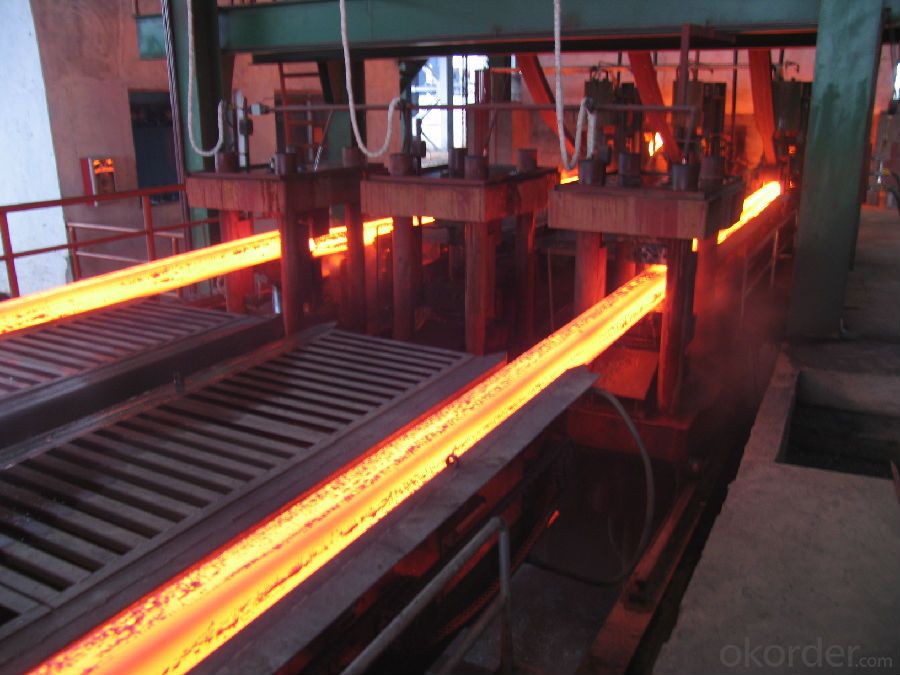
Specifications of Q235/3SP 70MM Blast Furnace Hot Rolled Steel Billet
Quality | Q/BQB 440-2003 | JIS G3312-1994 JIS G3321 | EN 10326-2004 | ASTM A653-02a |
EN 10327-2004 | (BASE PLATE) | |||
(BASE PLATE) | ||||
Commercial Steel | DC51D | SGCC SGLCC | DX51D+Z DX51D+AZ | CS Type A/B/C |
Forming Steel | St01,St02,St03 | SGCD1 SGLCD1 | FS Type A, Type B | |
Drawing | DC52D /DC53D | - | DX52D+Z DX52D+AZ | DDS TYPE A/C |
Steel | DX53D+Z DX53D+AZ | |||
Structural | S280GD (StE28) | SGC400 SGLC400 | S280D+Z DX54D+AZ | SS275 |
Steel | S350GD (StE34) | SGC440 SGLC440 | S350D+Z S350D+AZ | SS340 Class1 |
FAQ of Q235/3SP 70MM Blast Furnace Hot Rolled Steel Billet
We have organized several common questions for our clients,may help you sincerely:
1. How Can I Visit There?
Our company is located in Tianjin City, China, near Beijing. You can fly to Tianjin Airport Directly. All our clients, from home or aboard, are warmly welcome to visit us!
2. How Can I Get Some Sample?
We are honored to offer you sample.
3. Why choose CNBM?
Our delivery time about 15-20days for standard sizes, if you have other requirements like hardness, quanity and width ,it is about 20-40days. But don't worry we also try our best for the delivery time ,because time longer and our cost is higher.
- Q: What are the main factors that affect the availability of steel billets?
- The availability of steel billets is affected by various key factors. First and foremost, the availability of raw materials plays a critical role. Steel billets are produced by melting iron ore, alongside other materials like coal and limestone, in a blast furnace. The production of steel billets can be greatly influenced by the availability and cost of these raw materials. Any disruptions in the supply chain, such as a shortage of iron ore or a sudden increase in prices, can result in a decrease in the availability of steel billets. Additionally, the demand for steel billets also impacts their availability. The construction and manufacturing industries are the primary consumers of steel billets, as they use them to manufacture various steel products like bars, rods, and beams. If there is a surge in demand for steel products, it can strain the availability of steel billets, particularly if the production capacity is unable to keep pace with the increased demand. Moreover, market dynamics and economic conditions can have an effect on the availability of steel billets. Factors like fluctuations in steel prices, changes in government policies, and trade barriers can influence the overall supply and demand balance. For instance, the implementation of tariffs or restrictions on steel imports can reduce the availability of steel billets in a specific region, as domestic production may not be sufficient to meet the demand. Furthermore, technological advancements and production capabilities also contribute to determining the availability of steel billets. Enhancements in manufacturing processes, such as the utilization of electric arc furnaces or continuous casting, can enhance production efficiency and output. Conversely, any technical issues or maintenance problems in steel plants can disrupt production and subsequently decrease the availability of steel billets. In conclusion, the availability of steel billets is influenced by factors such as the availability and cost of raw materials, the demand for steel products, market dynamics, economic conditions, and technological advancements. These factors, either individually or collectively, can impact the availability of steel billets. It is crucial for stakeholders in the steel industry to monitor and address these factors in order to ensure a stable supply of steel billets.
- Q: How are steel billets used in the production of electrical transmission towers?
- Steel billets are used in the production of electrical transmission towers as they serve as the raw material for the manufacturing process. These billets are melted and then shaped into the required sections and components of the transmission tower, such as the main legs, cross arms, and braces. They undergo further processing, including cutting, drilling, and welding, to form the final structure. The strength and durability of steel make it an ideal material for transmission towers, ensuring they can withstand the weight of electrical cables and withstand harsh environmental conditions.
- Q: Can steel billets be customized in terms of shape and size?
- Yes, steel billets can be customized in terms of shape and size. They can be fabricated into various shapes and sizes to meet specific requirements and applications.
- Q: How do steel billets contribute to the manufacturing of renewable energy systems?
- Steel billets play a crucial role in the manufacturing of renewable energy systems by providing the necessary foundation for various components. These billets are essentially semi-finished steel products that are cast into a specific shape, making them highly versatile and adaptable to different renewable energy applications. One of the primary ways steel billets contribute to the manufacturing of renewable energy systems is through the construction of wind turbines. Wind turbines require a robust and stable structure to support the blades and the generator. Steel billets are used to create the tower, which serves as the backbone of the wind turbine. These towers need to withstand extreme weather conditions and support the weight of the blades, making the strength and durability of steel crucial. Similarly, steel billets are used in the manufacturing of solar energy systems, particularly in the production of photovoltaic (PV) panels. Steel frames are utilized to provide structural support for the PV panels, ensuring they are securely mounted and can withstand various environmental conditions. Additionally, steel billets are used in the manufacturing of solar trackers, which optimize the positioning of PV panels to maximize energy generation by following the sun's path throughout the day. Moreover, steel billets contribute to the production of hydroelectric power systems. In hydroelectric power plants, large turbines are used to convert the energy from flowing water into electricity. These turbines require sturdy and reliable components, including shafts and other mechanical parts that are often made from steel billets. The high strength and resistance to corrosion of steel make it an ideal material for these applications. Furthermore, steel billets are utilized in the manufacturing of energy storage systems, such as batteries. These billets are employed to create durable and secure enclosures for the batteries, ensuring their protection and safe operation. Steel's ability to withstand high temperatures and its resistance to fire make it a suitable choice for battery housing and containment. In summary, steel billets are essential in the manufacturing of renewable energy systems as they provide the strength, durability, and versatility required for various components. Whether it is wind turbines, solar panels, hydroelectric turbines, or energy storage systems, steel billets play a crucial role in enabling the reliable and efficient generation of renewable energy.
- Q: How are steel billets used in the production of steel cables?
- Steel billets are an integral component in the production of steel cables. These billets serve as the raw material from which the cables are made. To produce steel cables, the billets undergo a series of processes. Firstly, the steel billets are heated in a furnace to extremely high temperatures, which makes them malleable and easier to work with. This process is known as annealing. The billets are then passed through a series of rollers to shape them into the desired form and size for the cables. Next, the shaped billets are passed through a wire drawing machine where they are pulled through a series of dies to reduce their diameter and increase their length. This results in a wire-like structure known as a wire rod. These wire rods are then further processed through a series of machines to clean and remove any impurities or surface defects. They are then coated with lubricants to reduce friction during the subsequent processes. The wire rods are then passed through a wire stranding machine, where multiple wires are twisted together to form strands. These strands are then combined together, either by twisting or braiding, to form the final steel cables. The cables are once again coated with lubricants to improve their durability and resistance to corrosion. Overall, steel billets play a crucial role in the production of steel cables as they serve as the starting material for the entire process. Through a series of heating, shaping, and drawing processes, the billets are transformed into wire rods, which are then further processed to create the strands and eventually the final steel cables.
- Q: Billet heating furnace prices?
- The reheating furnace control mode according to the different tonnage, heating medium, price range, or recommendations according to your requirements, find good few industry units do offer the program, compared to eradicate the solution and quotation.
- Q: What is the role of steel billets in the production of wire rods?
- Steel billets are a crucial raw material in the production of wire rods. They serve as the starting point for the wire rod manufacturing process. The billets are heated and then passed through a series of rolling mills to reduce their thickness and shape them into wire rods. This process helps to improve the mechanical properties and surface quality of the wire rods. Therefore, steel billets play a significant role in ensuring the quality and strength of wire rods used in various industries such as construction, automotive, and manufacturing.
- Q: How are steel billets used in the production of forged parts?
- Forged parts rely heavily on steel billets, as they are crucial for their production. These billets act as the initial material from which the desired shape and size of the forged part are achieved. To commence the process, steel billets are subjected to specific heating, which renders them more malleable. This heating, referred to as forging temperature, allows the steel to be easily manipulated without any risk of cracking or breaking. The elevated temperature also enhances the structural integrity of the billets and makes them more resistant to deformation during the forging procedure. Once the steel billets reach the desired temperature, they are positioned onto a forging press or hammer. The press exerts immense pressure on the billets, compelling them to take the form of the die or mold within which they are placed. This procedure, known as forging, enables the creation of intricate details and complex shapes that cannot be achieved through alternative manufacturing techniques. The forged parts crafted from steel billets are renowned for their exceptional strength, durability, and resistance to wear and tear. They find extensive application in various industries, including automotive, aerospace, oil and gas, and construction. Forged parts can range from small components like gears and bolts to larger items such as crankshafts, connecting rods, and turbine blades. In conclusion, steel billets play a vital role in the production of forged parts by serving as the raw material that undergoes shaping and forming during the forging process. The resulting forged parts exhibit superior mechanical properties and are indispensable components in numerous industrial applications.
- Q: How does the market demand for steel billets fluctuate over time?
- The demand for steel billets in the market can change due to a variety of factors. One of the main drivers of demand is the overall state of the economy. When the economy is doing well, there is usually a higher demand for steel billets because they are an important raw material for industries like construction, automotive, and manufacturing. On the other hand, during economic downturns or recessions, the demand for steel billets tends to decrease as these industries reduce their production and investment. Another factor that can affect the market demand for steel billets is the construction industry. Projects related to infrastructure, real estate, and urbanization can increase the demand for steel billets, as they are necessary for building structures like buildings and bridges. Changes in government policies or regulations regarding infrastructure spending can also have an impact on the demand for steel billets. Furthermore, the automotive industry plays a significant role in the demand for steel billets. As the automotive sector grows or declines, the demand for steel billets used in the production of automobile parts and components can change accordingly. Global trade and international relations can also influence the market demand for steel billets. Factors like tariffs, trade agreements, and geopolitical tensions can affect the supply and demand dynamics, leading to fluctuations in demand. For example, increased protectionism or trade barriers can result in reduced demand for steel billets in certain markets. Lastly, technological advancements and changes in consumer preferences can have an impact on the demand for steel billets. For instance, the increased use of alternative materials like aluminum or composites in certain industries may decrease the demand for steel billets. Additionally, shifts in consumer preferences towards more sustainable or lightweight products can also affect the demand for steel billets. In conclusion, the demand for steel billets in the market can change due to factors such as economic conditions, construction industry activity, automotive industry trends, global trade dynamics, and technological advancements. It is important for market participants to understand these factors and their potential impacts in order to anticipate and adapt to changes in demand for steel billets.
- Q: What is the role of steel billets in the manufacturing of automotive transmission systems?
- Steel billets play a crucial role in the manufacturing of automotive transmission systems. These billets are raw material forms of steel that are used as a starting point for shaping and forming various components of the transmission system. One of the main uses of steel billets in the manufacturing process is for the production of gears, shafts, and other critical transmission components. These billets are forged or machined to create the desired shape, strength, and dimensional accuracy required for these components. The use of steel billets ensures that these parts possess the necessary strength, durability, and resistance to wear and tear, which are essential for the proper functioning of the transmission system. Additionally, steel billets are also utilized in the production of transmission casings. These casings provide the housing and protection for the internal components of the transmission system. Steel billets are cast or molded into the desired shape to create these casings, ensuring they have the necessary strength and rigidity to withstand the forces and stresses experienced by the transmission system. Moreover, the use of steel billets allows for the customization and optimization of the transmission system components. Manufacturers can choose specific grades of steel billets based on their desired properties, such as hardness, toughness, or corrosion resistance. This flexibility enables the production of transmission systems that meet the specific requirements of different automotive applications, whether it be for high-performance vehicles or heavy-duty trucks. In summary, steel billets are integral to the manufacturing of automotive transmission systems. They provide the raw material from which gears, shafts, casings, and other components are formed. Steel billets ensure the strength, durability, and customization potential necessary to create reliable and efficient transmission systems for various automotive applications.
Send your message to us
Q235/3SP 70MM Blast Furnace Hot Rolled Steel Billet
- Loading Port:
- Tianjin
- Payment Terms:
- TT OR LC
- Min Order Qty:
- 2000 m.t.
- Supply Capability:
- 30000 m.t./month
OKorder Service Pledge
OKorder Financial Service
Similar products
Hot products
Hot Searches
Related keywords
